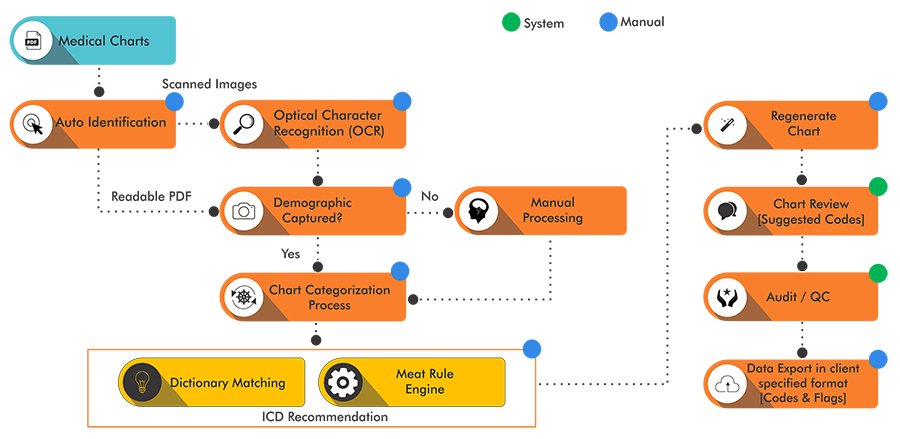The Hierarchical condition category (HCC) coding division at Vee Healthtek was growing quickly. Staffed with over 500 coders, Vee Healthtek required efficiency in mass chart volume management with superior quality standards. A high demand for experience certified HCC coders increased wages and created challenges with recruitment and retention. Solutions were sought from their own seasoned information technologies (IT) services veteran, the General Manager of Analytics at Vee Healthtek.
The GM assembled and led a team of nine IT experts, two data scientists, and twelve medical coders who collaborated to develop a proprietary system called the Vee Healthtek Coding Assistance Platform (CAP). The use of Optical Character Recognition (OCR) and Artificial Intelligence (AI) was also incorporated into a plan to reduce reliance on human resources.
CAP is an evolution of solutions. In 2016, Vee Healthtek initiated investment in this technology to eliminate the need for scrolling through large medical charts by automating the capturing, validating, and summarizing of critical data points from medical charts. Then, in 2017, CAP initiated automated extraction of relevant medical chart data, such as dates of service (DOS) and provider names, to further assist coders. The true power of CAP was realized in 2018 with the development of a custom-built medical coding rules engine. Monitoring, Evaluating, Assessing, and Treatment (MEAT) rules engine utilizes AI to correctly identify and capture HCC codes within medical charts.
The Process
The process begins with an import of digital Electronic Medical Records (EMR) charts and scanned paper charts. Scanned charts undergo an OCR step to convert text to a readable format. The system then automatically captures demographics. Illegible charts are sent to be manually keyed by a processor.
The chart is then broken down into subsections as follows:
- Consult Note/Consultation Letters
- Demographics/Fact sheet
- Discharge Summaries
- Electrocardiogram (EKG) Reports
- Health Assessment Forms
- History and Physical
- Medication Lists
- Problem Lists
-
Progress Notes/Office Notes
Once this occurs, AI engines match the captured data against the customized rules engine. The system determines and validates HCC codes found in the chart. CAP then regenerates the chart with a cover page containing chart type, category details, demographic mismatch indicators, and hyperlinked combo codes. The hyperlink takes the coder directly to the page and section where the code was found in the original chart. Finally, the chart and captured data is ready to be reviewed by a coder and auditor. The coder can quickly navigate through the document without having to validate that each page matches the correct patient and provider. Hyperlinks allow the coder to efficiently review the diagnosis context and make necessary corrections or additions. The audit process is completely customizable based on variables such as system confidence levels, coder experience level, random sampling size, and more.
Use of CAP has resulted in a 35% reduction in coding time without sacrificing quality levels. It is also a “learning system,” producing improvements in engine accuracy with increased processing of chart volumes. Vee Healthtek expects continued coding speed increases, resulting in faster turnaround with fewer staff. Importantly, we have found that the efficiencies in coding created by the system’s automation aspect allows for more auditing time, resulting in improved quality levels and maintenance of new efficiency benchmarks.

